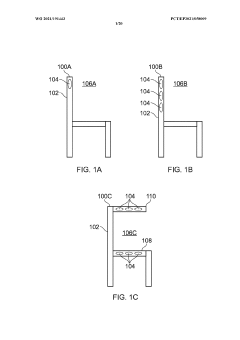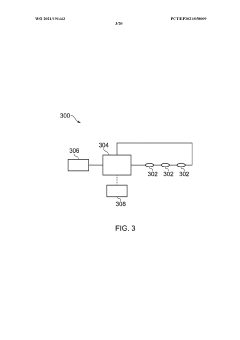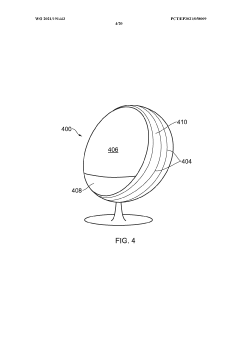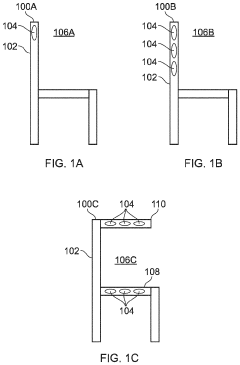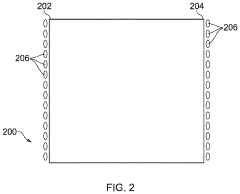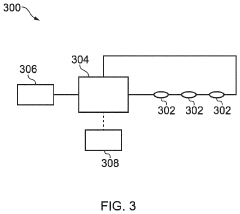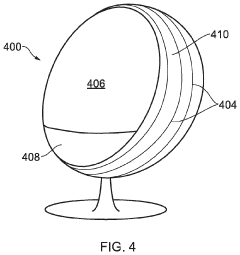Understanding Schumann Resonance: Fundamental Concepts
JUN 24, 20259 MIN READ
Generate Your Research Report Instantly with AI Agent
Patsnap Eureka helps you evaluate technical feasibility & market potential.
Schumann Resonance Background and Objectives
The Schumann resonance, discovered by physicist Winfried Otto Schumann in 1952, is a set of spectral peaks in the extremely low frequency (ELF) portion of the Earth's electromagnetic field spectrum. This phenomenon is closely tied to the electrical activity in Earth's atmosphere, particularly lightning discharges. The fundamental concept behind Schumann resonance is that the space between the Earth's surface and the ionosphere acts as a waveguide, creating a resonant cavity for electromagnetic waves.
The primary objective of studying Schumann resonance is to gain a deeper understanding of the Earth's electromagnetic environment and its interactions with various geophysical and atmospheric processes. This research has far-reaching implications across multiple scientific disciplines, including atmospheric science, geophysics, and even potential applications in human health and cognition studies.
Historically, the development of Schumann resonance research has been closely linked to advancements in radio technology and our understanding of the Earth's ionosphere. Early observations of these resonances were challenging due to their extremely low frequencies and the need for highly sensitive equipment. However, as technology progressed, more accurate measurements became possible, leading to a surge in research interest during the latter half of the 20th century.
The fundamental frequency of Schumann resonance is approximately 7.83 Hz, with subsequent harmonics occurring at approximately 14.3, 20.8, 27.3, and 33.8 Hz. These frequencies are not constant and can vary slightly due to various factors such as solar activity, ionospheric conditions, and global lightning activity. Understanding these variations and their causes is a key focus of ongoing research in this field.
One of the most intriguing aspects of Schumann resonance is its potential connection to biological systems. Some researchers have suggested that these resonances may have an influence on human brainwave patterns and circadian rhythms, although this remains a topic of debate and ongoing investigation. This potential link has sparked interest in fields beyond traditional geophysics, including bioelectromagnetics and even certain areas of alternative medicine.
As we look towards the future, the study of Schumann resonance continues to evolve. Advanced monitoring systems and global networks of ELF receivers are providing unprecedented data on these resonances, allowing for more detailed analysis of their behavior and potential correlations with other Earth system processes. Additionally, there is growing interest in how Schumann resonances might be affected by or indicative of global climate change, offering a new perspective on monitoring our planet's changing environment.
The primary objective of studying Schumann resonance is to gain a deeper understanding of the Earth's electromagnetic environment and its interactions with various geophysical and atmospheric processes. This research has far-reaching implications across multiple scientific disciplines, including atmospheric science, geophysics, and even potential applications in human health and cognition studies.
Historically, the development of Schumann resonance research has been closely linked to advancements in radio technology and our understanding of the Earth's ionosphere. Early observations of these resonances were challenging due to their extremely low frequencies and the need for highly sensitive equipment. However, as technology progressed, more accurate measurements became possible, leading to a surge in research interest during the latter half of the 20th century.
The fundamental frequency of Schumann resonance is approximately 7.83 Hz, with subsequent harmonics occurring at approximately 14.3, 20.8, 27.3, and 33.8 Hz. These frequencies are not constant and can vary slightly due to various factors such as solar activity, ionospheric conditions, and global lightning activity. Understanding these variations and their causes is a key focus of ongoing research in this field.
One of the most intriguing aspects of Schumann resonance is its potential connection to biological systems. Some researchers have suggested that these resonances may have an influence on human brainwave patterns and circadian rhythms, although this remains a topic of debate and ongoing investigation. This potential link has sparked interest in fields beyond traditional geophysics, including bioelectromagnetics and even certain areas of alternative medicine.
As we look towards the future, the study of Schumann resonance continues to evolve. Advanced monitoring systems and global networks of ELF receivers are providing unprecedented data on these resonances, allowing for more detailed analysis of their behavior and potential correlations with other Earth system processes. Additionally, there is growing interest in how Schumann resonances might be affected by or indicative of global climate change, offering a new perspective on monitoring our planet's changing environment.
Applications and Market Potential
Schumann resonances, the electromagnetic oscillations occurring in the Earth-ionosphere cavity, have garnered significant attention for their potential applications across various sectors. The market potential for technologies leveraging these resonances is diverse and expanding, with applications ranging from environmental monitoring to human health and beyond.
In the realm of environmental science and geophysics, Schumann resonances offer a unique tool for global lightning activity monitoring. This capability has substantial market potential in weather forecasting and climate change research. Meteorological agencies and climate research institutions are increasingly interested in integrating Schumann resonance data into their predictive models, potentially driving demand for specialized monitoring equipment and data analysis software.
The telecommunications industry presents another promising market for Schumann resonance applications. These natural frequencies could be utilized for long-range, low-frequency communication systems, particularly in scenarios where traditional methods are impractical or unreliable. This application could find a niche in remote area communications, underwater signaling, or even as a backup for satellite communications during solar storms.
In the field of human health and wellness, there's growing interest in the potential effects of Schumann resonances on human physiology. Some researchers hypothesize that these resonances may influence circadian rhythms and overall well-being. This has led to the development of various wellness products claiming to replicate or enhance exposure to these natural frequencies. While scientific validation is ongoing, this sector represents a burgeoning market with potential for growth in personal health devices and therapeutic applications.
The aerospace industry is another sector where Schumann resonance technology could find significant applications. These resonances could potentially be used for navigation and positioning systems, offering an alternative or complement to GPS, especially in environments where satellite signals are compromised. This application could be particularly valuable for unmanned aerial vehicles (UAVs) and other autonomous systems operating in challenging environments.
In the realm of geophysical exploration, Schumann resonances could provide a novel method for subsurface imaging and resource detection. This technology could offer a non-invasive means of exploring underground structures, potentially revolutionizing mineral exploration and geological surveys. The mining and oil industries might become significant markets for such applications.
As research in this field progresses, we can anticipate the emergence of new markets and applications. The interdisciplinary nature of Schumann resonance research suggests that innovations could arise from unexpected quarters, potentially leading to disruptive technologies in fields as diverse as quantum computing, consciousness studies, and extraterrestrial communication.
In the realm of environmental science and geophysics, Schumann resonances offer a unique tool for global lightning activity monitoring. This capability has substantial market potential in weather forecasting and climate change research. Meteorological agencies and climate research institutions are increasingly interested in integrating Schumann resonance data into their predictive models, potentially driving demand for specialized monitoring equipment and data analysis software.
The telecommunications industry presents another promising market for Schumann resonance applications. These natural frequencies could be utilized for long-range, low-frequency communication systems, particularly in scenarios where traditional methods are impractical or unreliable. This application could find a niche in remote area communications, underwater signaling, or even as a backup for satellite communications during solar storms.
In the field of human health and wellness, there's growing interest in the potential effects of Schumann resonances on human physiology. Some researchers hypothesize that these resonances may influence circadian rhythms and overall well-being. This has led to the development of various wellness products claiming to replicate or enhance exposure to these natural frequencies. While scientific validation is ongoing, this sector represents a burgeoning market with potential for growth in personal health devices and therapeutic applications.
The aerospace industry is another sector where Schumann resonance technology could find significant applications. These resonances could potentially be used for navigation and positioning systems, offering an alternative or complement to GPS, especially in environments where satellite signals are compromised. This application could be particularly valuable for unmanned aerial vehicles (UAVs) and other autonomous systems operating in challenging environments.
In the realm of geophysical exploration, Schumann resonances could provide a novel method for subsurface imaging and resource detection. This technology could offer a non-invasive means of exploring underground structures, potentially revolutionizing mineral exploration and geological surveys. The mining and oil industries might become significant markets for such applications.
As research in this field progresses, we can anticipate the emergence of new markets and applications. The interdisciplinary nature of Schumann resonance research suggests that innovations could arise from unexpected quarters, potentially leading to disruptive technologies in fields as diverse as quantum computing, consciousness studies, and extraterrestrial communication.
Current Understanding and Challenges
Schumann resonances, discovered by physicist Winfried Otto Schumann in 1952, are global electromagnetic resonances generated and excited by lightning discharges in the cavity formed by the Earth's surface and the ionosphere. The current understanding of this phenomenon has significantly advanced since its discovery, yet several challenges remain in fully comprehending its intricacies.
The fundamental frequency of Schumann resonances is approximately 7.83 Hz, with subsequent harmonics occurring at approximately 14.3, 20.8, 27.3, and 33.8 Hz. These resonances are sustained by global lightning activity, which strikes the Earth about 50 times per second. The resonances are observed as distinct peaks in the extremely low frequency (ELF) portion of the Earth's electromagnetic field spectrum.
Recent advancements in measurement techniques and data analysis have improved our ability to detect and study Schumann resonances. High-sensitivity magnetometers and sophisticated signal processing algorithms now allow for more accurate measurements of these weak electromagnetic signals. This has led to a better understanding of the global lightning distribution and its relationship to climate patterns.
One of the primary challenges in Schumann resonance research is the difficulty in isolating these weak signals from background noise and anthropogenic electromagnetic interference. Urban environments, in particular, pose significant challenges for accurate measurements due to the prevalence of man-made electromagnetic fields.
Another ongoing challenge is the complex nature of the Earth-ionosphere cavity. The ionosphere's properties vary with altitude, latitude, time of day, and solar activity, making it challenging to create accurate models of Schumann resonance propagation. Furthermore, the cavity's shape is not perfectly spherical, which introduces additional complexities in theoretical calculations.
The potential applications of Schumann resonance research extend beyond atmospheric science. Some studies suggest a possible link between these resonances and biological processes, including human brain activity. However, these claims remain controversial and require further investigation to establish any definitive connections.
Climate change and its effects on global lightning patterns present another challenge in Schumann resonance research. As climate patterns shift, the distribution and frequency of lightning strikes may change, potentially altering the characteristics of Schumann resonances. Understanding these changes could provide valuable insights into global climate dynamics.
In conclusion, while significant progress has been made in understanding Schumann resonances, numerous challenges persist. Overcoming these obstacles will require continued advancements in measurement techniques, theoretical modeling, and interdisciplinary collaboration to fully unlock the potential of this fascinating global phenomenon.
The fundamental frequency of Schumann resonances is approximately 7.83 Hz, with subsequent harmonics occurring at approximately 14.3, 20.8, 27.3, and 33.8 Hz. These resonances are sustained by global lightning activity, which strikes the Earth about 50 times per second. The resonances are observed as distinct peaks in the extremely low frequency (ELF) portion of the Earth's electromagnetic field spectrum.
Recent advancements in measurement techniques and data analysis have improved our ability to detect and study Schumann resonances. High-sensitivity magnetometers and sophisticated signal processing algorithms now allow for more accurate measurements of these weak electromagnetic signals. This has led to a better understanding of the global lightning distribution and its relationship to climate patterns.
One of the primary challenges in Schumann resonance research is the difficulty in isolating these weak signals from background noise and anthropogenic electromagnetic interference. Urban environments, in particular, pose significant challenges for accurate measurements due to the prevalence of man-made electromagnetic fields.
Another ongoing challenge is the complex nature of the Earth-ionosphere cavity. The ionosphere's properties vary with altitude, latitude, time of day, and solar activity, making it challenging to create accurate models of Schumann resonance propagation. Furthermore, the cavity's shape is not perfectly spherical, which introduces additional complexities in theoretical calculations.
The potential applications of Schumann resonance research extend beyond atmospheric science. Some studies suggest a possible link between these resonances and biological processes, including human brain activity. However, these claims remain controversial and require further investigation to establish any definitive connections.
Climate change and its effects on global lightning patterns present another challenge in Schumann resonance research. As climate patterns shift, the distribution and frequency of lightning strikes may change, potentially altering the characteristics of Schumann resonances. Understanding these changes could provide valuable insights into global climate dynamics.
In conclusion, while significant progress has been made in understanding Schumann resonances, numerous challenges persist. Overcoming these obstacles will require continued advancements in measurement techniques, theoretical modeling, and interdisciplinary collaboration to fully unlock the potential of this fascinating global phenomenon.
Measurement Techniques and Instrumentation
01 Schumann resonance devices for health and wellness
Various devices have been developed to generate or utilize Schumann resonance frequencies for potential health benefits. These devices aim to simulate the natural electromagnetic frequencies of the Earth to promote relaxation, improve sleep quality, and enhance overall well-being. Some designs incorporate Schumann resonance generators into everyday objects or wearable devices for convenient use.- Schumann resonance devices for health and wellness: Various devices are designed to generate or utilize Schumann resonance frequencies for potential health benefits. These devices aim to simulate the natural electromagnetic frequencies of the Earth to promote relaxation, improve sleep quality, and enhance overall well-being. Some implementations include wearable devices, room-based generators, and portable units that emit Schumann resonance frequencies.
- Schumann resonance in environmental monitoring and protection: Schumann resonance is utilized in environmental monitoring systems to detect and analyze electromagnetic disturbances in the Earth's atmosphere. These systems can be used for early warning of natural disasters, climate change studies, and monitoring of electromagnetic pollution. Applications include atmospheric research, geophysical exploration, and environmental protection.
- Integration of Schumann resonance in electronic devices: Electronic devices, such as smartphones, tablets, and wearables, are being designed to incorporate Schumann resonance technology. This integration aims to counteract the potential negative effects of artificial electromagnetic fields and provide users with a more natural electromagnetic environment. Some devices include built-in Schumann resonance generators or receivers.
- Schumann resonance in agriculture and plant growth: Research and applications of Schumann resonance in agriculture focus on its potential effects on plant growth and crop yield. Devices and systems are being developed to expose plants to Schumann resonance frequencies, aiming to enhance growth rates, improve resistance to pests and diseases, and increase overall crop productivity.
- Schumann resonance in energy harvesting and wireless power transmission: Innovative approaches are being explored to harness Schumann resonance for energy harvesting and wireless power transmission. These technologies aim to tap into the Earth's natural electromagnetic field as a potential source of clean energy. Applications include powering remote sensors, IoT devices, and small electronic equipment in areas where traditional power sources are unavailable.
02 Schumann resonance in environmental monitoring and research
Schumann resonance is utilized in environmental monitoring systems and research equipment. These applications focus on measuring and analyzing the Earth's electromagnetic field variations for scientific studies, weather prediction, and geophysical research. Specialized sensors and data processing techniques are employed to detect and interpret Schumann resonance signals.Expand Specific Solutions03 Integration of Schumann resonance in therapeutic devices
Therapeutic devices incorporating Schumann resonance technology have been developed for potential medical applications. These devices aim to combine the purported benefits of Schumann resonance with other therapeutic modalities, such as massage, acupuncture, or light therapy. The goal is to create comprehensive treatment systems that may address various health concerns.Expand Specific Solutions04 Schumann resonance in electromagnetic shielding and protection
Innovations in electromagnetic shielding and protection systems incorporate Schumann resonance concepts. These developments aim to create environments that maintain beneficial electromagnetic frequencies while shielding against potentially harmful electromagnetic radiation. Applications include protective clothing, building materials, and electronic device casings.Expand Specific Solutions05 Schumann resonance in energy harvesting and power systems
Research and development efforts explore the potential of harnessing Schumann resonance for energy generation or power system optimization. These innovations investigate methods to capture and utilize the Earth's natural electromagnetic energy for sustainable power solutions or to enhance the efficiency of existing power distribution systems.Expand Specific Solutions
Key Researchers and Institutions
The field of Schumann Resonance research is in a mature stage, with established principles and ongoing applications. The market size for related technologies is moderate but growing, driven by increasing interest in Earth-ionosphere interactions and potential health applications. Technologically, the field is well-developed, with companies like Siemens Healthineers AG and Koninklijke Philips NV leading in medical applications. Research institutions such as the University of Bern and Fraunhofer-Gesellschaft eV contribute to advancing the understanding of Schumann Resonances. Companies like Sensirion AG and INFICON AG are exploring sensor technologies that may have applications in this field, indicating a trend towards more precise measurement and analysis capabilities.
Telefonaktiebolaget LM Ericsson
Technical Solution: Ericsson has explored the potential applications of Schumann resonance monitoring in telecommunications. Their research focuses on utilizing Schumann resonance measurements to improve long-distance communication systems and enhance the reliability of wireless networks. Ericsson's approach involves developing specialized antennas and receivers capable of detecting Schumann resonances and integrating this information into their network management systems to predict and mitigate electromagnetic interference.
Strengths: Strong potential for practical applications in telecommunications, extensive resources for research and development. Weaknesses: Relatively new area of research for the company, challenges in translating scientific concepts into commercial products.
University of Bern
Technical Solution: The University of Bern has developed a comprehensive research program focused on Schumann resonance monitoring and analysis. Their approach combines ground-based measurements with satellite data to create a global picture of Schumann resonance activity. The university has also pioneered techniques for separating Schumann resonance signals from other electromagnetic noise, improving the accuracy of measurements. Their research extends to investigating the potential links between Schumann resonances and various atmospheric and space weather phenomena.
Strengths: Holistic approach combining multiple data sources, strong focus on fundamental research, and potential for new scientific discoveries. Weaknesses: Limited direct commercial applications, reliance on external funding for continued research.
Theoretical Models and Simulations
A magnetic field exposure system and uses thereof
PatentWO2021191443A1
Innovation
- A magnetic field exposure system generating an amplitude-modulated low frequency magnetic field with a carrier frequency of 360 to 450 Hz and a modulation frequency of 0.5 to 100 Hz, with a field strength of 0.5 to 250 mT, specifically designed to expose organic cells or tissues to improve cell survival, proliferation, reduce stress, and enhance well-being.
A magnetic field exposure system and uses thereof
PatentPendingUS20230372726A1
Innovation
- A magnetic field exposure system generating an amplitude-modulated low frequency magnetic field with a carrier frequency of 360 to 450 Hz and a modulation frequency of 0.5 to 100 Hz, providing a field strength of 0.5 to 250 μT, specifically designed to enhance cell survival, proliferation, reduce stress, and promote tissue regeneration.
Environmental Factors Affecting Schumann Resonance
The Schumann resonance, a set of spectral peaks in the Earth's electromagnetic field spectrum, is significantly influenced by various environmental factors. These factors can alter the resonance's frequency, amplitude, and overall behavior, making it a complex phenomenon to study and understand.
One of the primary environmental factors affecting Schumann resonance is solar activity. Solar flares and coronal mass ejections can cause disturbances in the Earth's ionosphere, leading to changes in the resonance patterns. During periods of high solar activity, the ionosphere becomes more ionized, which can result in increased conductivity and alterations to the resonance frequencies.
Seasonal variations also play a crucial role in modulating Schumann resonance. The Earth's tilt and its orbit around the sun lead to changes in solar radiation received at different latitudes throughout the year. This, in turn, affects the ionosphere's properties and the global lightning activity, both of which are key components in the generation and propagation of Schumann resonance.
Weather patterns and global climate phenomena have a significant impact on Schumann resonance. Thunderstorms, which are the primary source of excitation for these resonances, vary in frequency and intensity across different regions and seasons. El Niño and La Niña events, for instance, can shift global precipitation patterns, thereby altering the distribution and intensity of lightning activity worldwide.
Atmospheric composition changes, both natural and anthropogenic, can also influence Schumann resonance. Variations in greenhouse gas concentrations, particularly water vapor, can affect the conductivity of the lower atmosphere and impact the resonance characteristics. Additionally, large-scale events such as volcanic eruptions can inject particulates into the atmosphere, potentially altering its electrical properties.
Human activities, particularly those involving large-scale electromagnetic emissions, can interfere with Schumann resonance measurements. Power grids, radio transmissions, and other sources of electromagnetic pollution can create noise that masks or distorts the natural resonance signals, making accurate detection and analysis more challenging.
Geomagnetic activity, closely linked to solar activity, is another critical factor. Geomagnetic storms can cause significant perturbations in the Earth's magnetic field, which in turn affects the propagation of electromagnetic waves in the Earth-ionosphere cavity. These disturbances can lead to temporary shifts in Schumann resonance frequencies and amplitudes.
Understanding these environmental factors and their complex interactions is crucial for accurately interpreting Schumann resonance data and leveraging this phenomenon for various applications, including global lightning monitoring, ionospheric studies, and potentially even climate change research.
One of the primary environmental factors affecting Schumann resonance is solar activity. Solar flares and coronal mass ejections can cause disturbances in the Earth's ionosphere, leading to changes in the resonance patterns. During periods of high solar activity, the ionosphere becomes more ionized, which can result in increased conductivity and alterations to the resonance frequencies.
Seasonal variations also play a crucial role in modulating Schumann resonance. The Earth's tilt and its orbit around the sun lead to changes in solar radiation received at different latitudes throughout the year. This, in turn, affects the ionosphere's properties and the global lightning activity, both of which are key components in the generation and propagation of Schumann resonance.
Weather patterns and global climate phenomena have a significant impact on Schumann resonance. Thunderstorms, which are the primary source of excitation for these resonances, vary in frequency and intensity across different regions and seasons. El Niño and La Niña events, for instance, can shift global precipitation patterns, thereby altering the distribution and intensity of lightning activity worldwide.
Atmospheric composition changes, both natural and anthropogenic, can also influence Schumann resonance. Variations in greenhouse gas concentrations, particularly water vapor, can affect the conductivity of the lower atmosphere and impact the resonance characteristics. Additionally, large-scale events such as volcanic eruptions can inject particulates into the atmosphere, potentially altering its electrical properties.
Human activities, particularly those involving large-scale electromagnetic emissions, can interfere with Schumann resonance measurements. Power grids, radio transmissions, and other sources of electromagnetic pollution can create noise that masks or distorts the natural resonance signals, making accurate detection and analysis more challenging.
Geomagnetic activity, closely linked to solar activity, is another critical factor. Geomagnetic storms can cause significant perturbations in the Earth's magnetic field, which in turn affects the propagation of electromagnetic waves in the Earth-ionosphere cavity. These disturbances can lead to temporary shifts in Schumann resonance frequencies and amplitudes.
Understanding these environmental factors and their complex interactions is crucial for accurately interpreting Schumann resonance data and leveraging this phenomenon for various applications, including global lightning monitoring, ionospheric studies, and potentially even climate change research.
Interdisciplinary Implications
The Schumann resonance, a global electromagnetic phenomenon, has far-reaching implications across various scientific disciplines. In the field of atmospheric science, it serves as a valuable tool for monitoring global lightning activity and studying the Earth's ionosphere. Researchers utilize Schumann resonance data to investigate climate change impacts on thunderstorm patterns and to detect potential correlations with extreme weather events.
In geophysics, Schumann resonance measurements provide insights into the Earth's electromagnetic environment and its interactions with solar activity. This information is crucial for understanding space weather phenomena and their effects on satellite communications and power grids. Additionally, Schumann resonance observations contribute to the study of seismic activity, potentially aiding in earthquake prediction and monitoring.
The field of bioelectromagnetics has shown increasing interest in Schumann resonances due to their potential influence on human health and circadian rhythms. Some studies suggest that exposure to these natural electromagnetic frequencies may have physiological effects on living organisms, opening up new avenues for research in chronobiology and environmental medicine.
In the realm of telecommunications, understanding Schumann resonances is essential for developing robust communication systems that can operate in challenging electromagnetic environments. Engineers leverage this knowledge to design more resilient equipment and improve signal processing techniques for long-range communications.
The study of Schumann resonances also intersects with astrophysics and planetary science. By analyzing these resonances on Earth, scientists can develop models to predict and detect similar phenomena on other planets, potentially aiding in the search for habitable exoplanets.
In the field of quantum physics, Schumann resonances provide a unique platform for investigating the interaction between quantum systems and large-scale electromagnetic fields. This research may lead to advancements in quantum sensing and communication technologies.
As interdisciplinary research continues to expand, the Schumann resonance phenomenon serves as a bridge between diverse scientific fields, fostering collaboration and driving innovation across multiple domains. Its wide-ranging implications underscore the importance of continued study and exploration of this fundamental aspect of Earth's electromagnetic environment.
In geophysics, Schumann resonance measurements provide insights into the Earth's electromagnetic environment and its interactions with solar activity. This information is crucial for understanding space weather phenomena and their effects on satellite communications and power grids. Additionally, Schumann resonance observations contribute to the study of seismic activity, potentially aiding in earthquake prediction and monitoring.
The field of bioelectromagnetics has shown increasing interest in Schumann resonances due to their potential influence on human health and circadian rhythms. Some studies suggest that exposure to these natural electromagnetic frequencies may have physiological effects on living organisms, opening up new avenues for research in chronobiology and environmental medicine.
In the realm of telecommunications, understanding Schumann resonances is essential for developing robust communication systems that can operate in challenging electromagnetic environments. Engineers leverage this knowledge to design more resilient equipment and improve signal processing techniques for long-range communications.
The study of Schumann resonances also intersects with astrophysics and planetary science. By analyzing these resonances on Earth, scientists can develop models to predict and detect similar phenomena on other planets, potentially aiding in the search for habitable exoplanets.
In the field of quantum physics, Schumann resonances provide a unique platform for investigating the interaction between quantum systems and large-scale electromagnetic fields. This research may lead to advancements in quantum sensing and communication technologies.
As interdisciplinary research continues to expand, the Schumann resonance phenomenon serves as a bridge between diverse scientific fields, fostering collaboration and driving innovation across multiple domains. Its wide-ranging implications underscore the importance of continued study and exploration of this fundamental aspect of Earth's electromagnetic environment.
Unlock deeper insights with Patsnap Eureka Quick Research — get a full tech report to explore trends and direct your research. Try now!
Generate Your Research Report Instantly with AI Agent
Supercharge your innovation with Patsnap Eureka AI Agent Platform!
